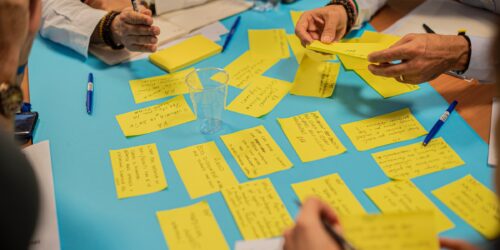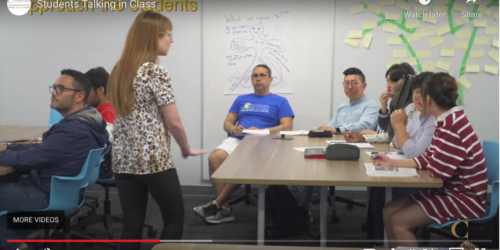Engage ALL Students with the Questions You Ask
As teachers, we all have one thing in common: we like to ask our students questions. The questions might ask to recall some important information related to your lesson. Or perhaps you ask deeper questions where they are asked to analyze a situation, an idea, or to strategize an outcome. But simply asking a question does not guarantee that your students will engage with it. If your goal is full engagement, then how you frame the delivery of a question can dramatically affect how students will participate with it. In this post, we explore the purpose of questioning and learn how to frame your questions so that everyone has an equitable chance to participate.
Why Do You Ask Questions?
Reflect for a moment on why you ask questions during your classes and make mental note. Then watch the short video below showing why some of your teaching colleagues ask questions as well.
Did you resonate with what you just watched and heard? If so, then you know you are in good company! Whether it is to test their thinking, recall information, or to push their thinking in new directions, we all want our students engaged with our lessons from the questions we created to support their learning.
Does Asking Questions Improve Learning?
The short answer is yes! Consider that question-asking is by far the most popular teaching ‘tool’ that teachers use to engage students during a lesson. This is a terrific teaching habit to develop, and a relatively easy one too, because according to Black and Wiliam (2010), “Improving questioning is one of the key ways to raise attainment”. The reason why is related to how we form memories. Simply stated, the primary purpose of a well-framed question is to prompt students to recall knowledge needed to answer that question. As a result, this act of recalling from memory literally strengthens the neural pathway to that knowledge. This makes the memory of that knowledge ‘sticky’ thereby making forgetting less likely in the future (Oakley & Sejnowski, 2021). Think of a well-worn path in a field created by people walking back-and-forth repeatedly. Similarly, the brain too creates a well-worn ‘path’ to knowledge where repeated recall strengthens neural links to that memory. This makes it almost effortless for you to find and recall that knowledge later on.
Framing Questions to Maximize Participation
Often during a lesson we find ourselves creating and asking short, information-seeking questions in-the-moment (sometimes called ‘cold-calling’). Imagine during a lesson you ask the following in-the-moment question, “Can someone name four math functions we have used in Excel?” As soon as we ask our question, we scan the room hoping for volunteers to raise their hand. It can be an agonizing wait for a hand to appear but as soon as we see one, we are likely to pick that person right away to answer, “Yes, Glenn, go ahead”. Or perhaps we ask the question then single out a particular student immediately to answer, “Can someone name four math functions we have used in Excel? Glenn?” You might notice that, in both cases, the question is framed in a way that only one student has an opportunity to participate and answer. If you see yourself in the scenarios above then just know that with a few simple changes on how you deliver your questions, you can involve every student in your class in forming an answer, which is exactly what you want to raise attainment.
How to Frame Questions to Maximize Participation
Let’s say you are planning to ask some questions during your next class. Perhaps you decide to plan out your questions ahead of time. If so, then consider reviewing the hand-out ‘The Spectrum of Effective Questioning’ that will aid you in the design of your questions. In the handout, you will find sentence starters for questions that evoke a wide range of thinking from lower-order questioning (recalling and understanding) and higher-order questioning (application and analysis). But often while teaching, a question you’d like to ask simply pops into your mind, and you then ask it in-the-moment.
Regardless of whether your questions are planned or asked in-the-moment, there are four simple actions to follow when framing your questions to maximize participation of your students.
1. Plan It, Then Ask It
This is the simplest part in framing questions, so go ahead and ask your question, whether planned or in-the-moment. Ideally though, you might plan out your questions ahead of the lesson, particularly if it will involve higher order thinking from your students to answer.
When planning your questions, consider phrasing them in a way that will ‘open’ them up to exploration toward a correct answer. For example, considering the earlier question “Can someone name four math functions we have used in Excel?” Now compare that question but with this small modification, “What are some possible math functions we have used in Excel?” Which of these two questions seems to be more inviting to participate with? The former question is framed so that if you are asked then you better know them all! The latter question that uses the words ‘some’ and ‘possible’ to frame the question encourages an exploration of the right answer. The student may know some of the functions, or they may know them all. Regardless, the invitation to participate the best they can is inferred by using these simple words. So, consider using exploratory words in your questions such as “some”, “might”, and “possible” as in “How might…? Why might…? Explain some ways…? What are some possible ways…?” These words are invitational in nature placing low demand on students to be completely correct in their answers.
2. Wait Time
In the excitement of keeping our lesson ‘flowing’ we might forget a crucial action after we ask a question: providing appropriate wait time to respond. The educational research on question asking is clear on this one action: providing more wait-time after asking a question increases the number of volunteers that contribute answers (Rowe, 1986). Why? This is because mental processing speeds needed to hear the question, process it, and formulate an answer will vary from student to student before they even raise their hand. Therefore, train yourself to give between 3 and 5 seconds of wait time (or longer) for students to process your question and formulate an answer. This action will be awkward at first for both teacher and student since there will be silence for what seems like an uncomfortably long period of time. But if you wait, it will pay off with more volunteers in answering your question. Keep in mind that the more complex the question you ask (see the Spectrum of Effective Questioning) the greater the wait time needed for students to process and respond.
3. Share Privately
Let’s combine wait time together with another powerful action: sharing answers privately with a partner. This is arguably the most important action you can encourage after you ask a question. Why? Sharing answers privately allows students to test out their understanding in a more psychologically safe environment than having to share immediately in front of their peers. Privately, students can recall information, articulate answers, repair their thinking, and challenge the thinking of others through conversation with a trusted peer before sharing publicly. Notice that in sharing privately you have ALL students engaging and conversing with your question which is exactly what you want if you hope to raise attainment.
You then might update the previous question like this: “What are some of the math functions we have been using in Excel? Turn to a partner and see if you can come up with at least four we have been using. I will give you 30 seconds to chat then ask a few of you to respond.” Note the exploratory language, wait time and private sharing in this version of the question.
4. Share Publicly
Now select a few students to share publicly. For example, after privately sharing, you might ask for a response this way, “Cynthia, what were some of the math functions you and Tai came up with? Inviting someone else into the conversation (Tai) might help Cynthia feel as if she has a partner to lean on if she forgets or simply needs help. This particular action is not critical, but it is kind and supportive toward your students. Finally, be aware of those students who may never wish to share publicly and respect their wishes if it ever arises.
Here is a summary sheet for these four actions. Download and print off to have it handy as to frame your questions during your lessons.
Finally, watch this short video about how this teacher delivers a question. Do you think he framed it well? Why or why not? Review the video with the four actions you learned in mind.
Conclusion
As you practice these four actions regularly in your classes, you will find they become a habitual part of your teacher toolbox. The most important habit to develop in your question-asking is giving wait time and providing time to share privately with a partner before sharing publicly. So, give these actions a try. As you practice more with them, I think you will see wonderful collaboration and conversation with your questions that engages ALL students while improving learning as a result. Win, win!
References
Oakley, B., & Sejnowski, T. J. (2021). Uncommon sense teaching: Practical insights in brain science to help students learn. Penguin.
Rowe, M. B. (1986). Wait Time: Slowing Down May Be A Way of Speeding Up! Journal of Teacher Education, 37(1), 43-50. https://doi.org/10.1177/002248718603700110
Black, P., & Wiliam, D. (2010). Inside the Black Box: Raising Standards through Classroom Assessment. Phi Delta Kappan, 92(1), 81-90.https://doi.org/10.1177/003172171009200119



